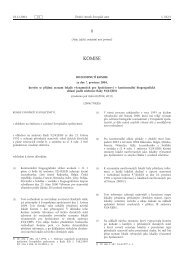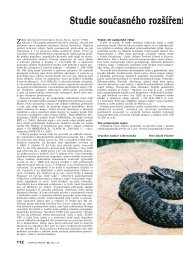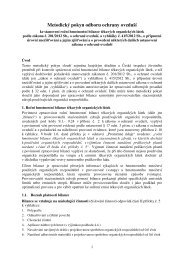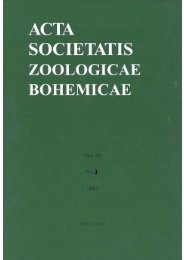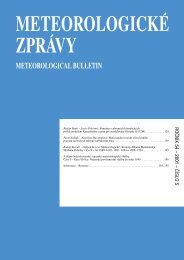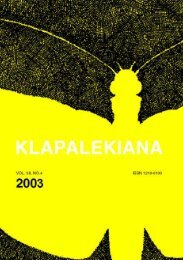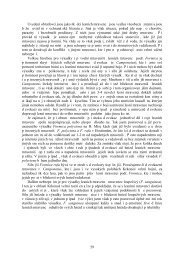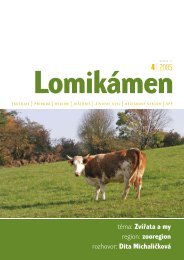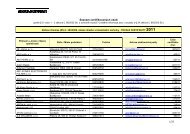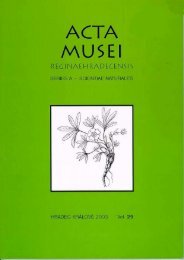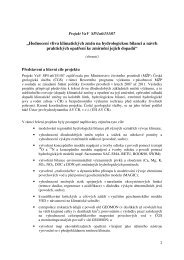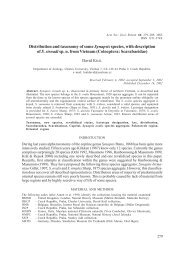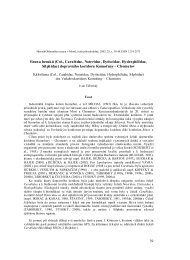journal of forest science
journal of forest science
journal of forest science
Create successful ePaper yourself
Turn your PDF publications into a flip-book with our unique Google optimized e-Paper software.
JOURNAL O OREST SCIENCE, 47, 2001 (7): 294–300<br />
Analyses <strong>of</strong> seed quality and germination in the Swiss Mountain<br />
Pine (Pinus mugo TURRA)<br />
L. HRABÍ<br />
Palacký University, Faculty <strong>of</strong> Pedagogy, Olomouc, Czech Republic<br />
ABSTRACT: This paper contains specific knowledge <strong>of</strong> detailed qualitative analyses <strong>of</strong> seeds <strong>of</strong> the Swiss Mountain Pine<br />
(Pinus mugo TURRA). Anatomical analyses, biochemical analyses and tests <strong>of</strong> germination were realized in 19 different<br />
individuals (from 19 areas) during four years <strong>of</strong> study. Uncommon results were obtained – incompletely developed embryos,<br />
polyembryony and abnormally germinating seeds.<br />
Keywords: seeds <strong>of</strong> Swiss Mountain Pine; detailed analyses; incompletely developed seeds; polyembryony; abnormally<br />
germinating seeds<br />
or many years nongerminating seeds or seeds with<br />
low germination have accounted for a large portion <strong>of</strong><br />
Swiss Mountain Pine seed production (JURÁSEK et al.<br />
1992; LOKVENC, ŠTURSA 1985). Some authors tried to<br />
stimulate seed germination by different physical and<br />
chemical methods (GOLJADKIN 1972; WORKS, BOVO<br />
1972). Their future practical use has not been verified<br />
yet, and there is not much information about morphological,<br />
biochemical and cytogenetic seed analyses (BEW-<br />
LEY, BLACK 1986).<br />
The condition <strong>of</strong> the morphologically developed Swiss<br />
Mountain Pine seed is that the embryo takes more than<br />
2/3 <strong>of</strong> the axial duct length (KHAN 1977). According to<br />
BEWLEY and BLACK (1986), ŠÈERBAKOVA (1966) nonvital<br />
seeds are those in which the polyembryony exist.<br />
Morphological changes are probably connected with biochemical<br />
processes. The seed quality is investigated by<br />
the biochemical tetrazolium test (ÈSN 48 1211 Zkoušky<br />
jakosti plodù a semen lesních døevin [ruit and Seed<br />
Quality Tests in orest Tree Species]; REHAP 1983).<br />
Other methods are based on quantitative and qualitative<br />
changes <strong>of</strong> saccharides in seeds (SIMANÈÍK 1967). It is<br />
only known from the cytogenetic analysis that plant species<br />
with big cell nuclei and low number <strong>of</strong> chromosomes<br />
are more sensitive to UV (ultraviolet) radiation than those<br />
with small nuclei and high chromosome number<br />
(KOVÁÈIK et al. 1976), and that a standard karyotype <strong>of</strong><br />
the Swiss Mountain Pine contains 24 chromosomes<br />
(PAZOURKOVÁ, PAZOUREK 1960).<br />
It is clear according to the above-mentioned information<br />
that no complex qualitative investigation <strong>of</strong> the Swiss<br />
Mountain Pine seeds has been made until now. That is<br />
why the aim <strong>of</strong> this experimental investigation was to<br />
study the vitality and quality <strong>of</strong> seeds and germination<br />
processes.<br />
MATERIAL AND METHODS<br />
The investigation was carried out for 4 years. Seeds<br />
from 19 individuals and from 19 areas <strong>of</strong> the Krkonoše<br />
Mts. (altitude 1,100–1,530 m a.s.l.) were examined. The<br />
origin <strong>of</strong> seed samples is given at the end <strong>of</strong> the Results<br />
section. After collection, seed extraction at 45°C and<br />
dewinging the seed analyses were made:<br />
a) content <strong>of</strong> full seeds (4 × 100 from each sample), according<br />
to the Standard ÈSN 48 2111 Jakost plodù<br />
a semen lesních døevin (ruit and Seed Quality in orest<br />
Tree Species);<br />
b) anatomical structure – content <strong>of</strong> vital and nonvital<br />
seeds (4 × 100 from each sample), analysed at the longitudinal<br />
section under a stereomicroscope Olympus<br />
(magnified 5 times), as nonvital were considered seeds<br />
with small embryos – smaller than 2/3 <strong>of</strong> the longitudinal<br />
length <strong>of</strong> the axial duct and seeds with 2 and more<br />
embryos – polyembryony;<br />
c) biochemical analysis – study <strong>of</strong> seed vitality in tetrazolium<br />
solution (prepared and applied according to the<br />
Standard ÈSN 48 2111); the development and colour<br />
were examined at a longitudinal section (4 × 100 seeds<br />
<strong>of</strong> each sample) under a stereomicroscope Olympus<br />
(magnified 5 times); nonvital seeds had other than red<br />
colour;<br />
d) after these anatomical and biochemical analyses <strong>of</strong><br />
each sample, the tests <strong>of</strong> germination (according to the<br />
294 J. FOR. SCI., 47, 2001 (7): 294–300



